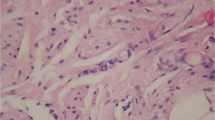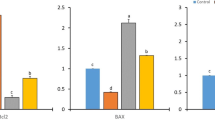Abstract
Although chemopreventive action of Biochanin A against various cancers including that of prostate, breast, colon, and fore-stomach has been reported earlier, none of the studies was made in prepubertal subjects. The present study appears to be the first one on prepubertal rats that indicates the efficacy of the test compound in the prevention of tumorigenesis. The antioxidative status and xenobiotic metabolism were also evaluated to understand the mechanism of Biochanin A induced prevention of cancer. For the tumorigenesis study 500 μg/g bwt of Biochanin A or vehicle dimethyl sulfoxide (DMSO) s.c, was injected at 16th, 18th, and 20th days post-partum followed by the administration of dimethylbenz[a]nthracene (DMBA) (80 μg/g bwt) at 50th day. In another set of experiments, to study the involvement of peroxidative process in the mechanism of action of test compound, different antioxidant parameters were studied following the administration of two different doses of Biochanin A (0.5 and 50 mg/kg bwt, through oral gavage for 10 days) in the prepubertal rats from day 16 post-partum. Results showed a significant reduction in the mammary tumors (more than 40%) in Biochanin A treated animals, as compared to animals treated with DMBA only. Spectrophotometric enzyme estimations revealed that the specific activities of antioxidant enzymes such as superoxide dismutase (SOD), catalase (CAT), glutathione peroxidase (GPx), glutathione transferase (GST), DT-diaphorase (DTD), and reduced glutathione (GSH) levels were increased, whereas specific activities of lactate dehydrogenase (LDH) and lipid peroxidation (LPO) were decreased significantly, both in liver as well as in mammary gland, in animals treated with Biochanin A prepubertally. These results reveal the possible involvement of the antioxidative and metabolic enzymes in the suppression of cancer burden and incidence in a prepubertal rat model suggesting that the intake of this phytoestrogen at an early stage may help in lowering the risk of mammary tumor.




Similar content being viewed by others
References
Adlercrreutz H, Mazur W (1997) Phytoestrogens and western diseases. Ann Med 29:95–120
Hsu JT, Hung HC, Chen CJ, Hsu WL, Ying C (1999) Effects of dietary phytoestrogen Biochanin A on cell growth in the mammary carcinoma cell line MCF-7. J Nutr Biochem 10(9):510–517
Chan HY, Wang H, Leung LK (2003) The red clover (Trifolium pratense) isoflavone Biochanin A modulates the biotransformation pathways of 7,12-dimethylbenz[a]anthracene. Br J Nutr 90(1):87–92
Ying C, Hsu JT, Hung HC, Lin DH, Chen LF, Wang LK (2002) Growth and cell cycle regulation by isoflavones in human breast carcinoma cells. Reprod Nutr Dev 42(1):55–64
Ying C, Hsu JT, Shieh SC (2001) Growth inhibition of human endothelial cells by the phytoestrogen Biochanin A, a metabolite of genistein. Br J Nutr 85(5):615–620
Peterson TG, Coward L, Kirk M, Falany CN, Barnes S (1996) The role of metabolism in mammary epithelial cell growth inhibition by the isoflavones genistein and Biochanin A. Carcinogenesis 17(9):1861–1869
Tham D, Gardener C, Haskell W (1998) Potential health benefits of dietary phytoestrogens: a review of the clinical, epidemiological and mechanistic evidence. J Clin Endocrinol Metabol 83:2223–2235
Goldin B, Adlercreutz H, Gorbach S, Woods M, Dweyer J, Conlon T, Bohn E, Gershoff S (1986) The relationship between estrogen levels and diets of Caucasian American and Oriental immigrant women. Am J Clin Nutr 44:945–953
Key T, Chen J, Pike M, Boreham J (1990) Sex hormones in women in rural China and Britain. Br J Cancer 62:632–636
Ziegler R, Hoover R, Pike M, Hidesheim A, Nomura A, West D, Wu-Williams A, Kolonel L, Horn-Ross P, Rosnthal J (1993) Migration patterns and breast cancer risk in Asian-American women. J Natl Cancer Inst 85:1819–1827
Murrill WB, Brown NM, Zang JX, Manzolillo PA, Barnes S, Lamartiniere CA (1996) Prepubertal genistein exposure suppresses mammary cancer and enhances gland differentiation in rats. Carcinogenesis 17(7):1454–1457
Gotoh T, Yamada K, Yin H, Ito A, Kataoka T, Dohi K (1998) Chemoprevention of N-nitroso-N methylurea-induced rat mammary carcinogenesis by soy foods or Biochanin A. Jpn J Cancer Res 89(2):137–142
Marklund S, Marklund G (1974) Involvement of superoxide anion radical in autooxidation of pyrogallol and a convenient assay for superoxide dismutase. Europ J Biochem 47:469–474
Aebi H (1984) Catalase in vitro. In: Colowick SP, Kaplan NO (eds) Methods in enzymology, Academic Press, New York, pp 121–126
Paglia DE, Valentine WM (1967) Studies on the quantitative and qualitative characterisation of erythrocyte glutathione peroxidase. J Lab Clin Med 70:158–169
Habig WH, Pabst MJ, Jacoby WB (1974) Glutathione-S-transferase: the enzymatic step in mercapturic acid formation. J Biol Chem 249:7130–7139
Ernster L, Daneilson L, Ljungrren M (1962) DTDiaphorase I. Purification from soluble fraction of rat liver cytoplasm. Biochemica Biophysica Acta 58:171–188
Bergmeyer HU, Bernt E (1974) Lactic dehydrogenase. Meth Enzym Anal 2:574–579
Moron MA, Dipierre IW, Mannervick B (1979) Levels of glutathione, glutathione reductase and glutathione-S-transferase activities in rat lung and liver. Biochemica Biophysica Acta 582:67–78
Varshney R, Kale RK (1990) Effects of calmodulin antagonists on radiation induced lipid peroxidation in microsomes. Int J Radiation Biol 58:533–543
Lowry OH, Rosebrough NH, Farr AL, Randall RJ (1951) Protein measurement with Folin phenol reagent. J Biol Chem 193:265–275
Sengupta A, Bhattacharjee S, Ghosh S (2005) Modulatory influence of Biochanin A on cyclooxygenase-2 and inducible nitric oxide synthase expression in azoxymethane induced colonic aberrant crypts. Int J Cancer Prevention 1(2):113–121
Lee YS, Kim TH, Cho KJ, Jang JJ (1992) Inhibitory effects of Biochanin A on benzo(a)pyrene induced carcinogenesis in mice. In vivo 6(3):283–286
Lee YS, Seo JS, Chung HT, Jang JJ (1991) Inhibitory effects on Biochanin A on mouse lung tumour induced by benzo(a)pyrene. J Korean Med Sci 6(4):325–328
Kettrer B (1998) Glutathione-S-transferase and prevention of cellular free radical damage. Free Radi Res 28:647–658
Monari M, Trinchero A, Calabrese C, Cattani O, Serrazanetti GP, Foschi J, Fabbri A, Zahlane D, Di Febo G, Tonini V, Cervellera M, Tosi MR, Tugnoli V (2006) Superoxide dismutase in gastric adenocarcinoma : is it a clinical biomarker in the development of cancer? Biomarkers 11(6):574–584
Manju V, Balasubramanian V, Nalini N (2002) Oxidative stress and tumour markers in cervical cancer patients. J Biochem Mol Biol Biophys Dec 6(6):387–390
Usami H, Kusano Y, Kumagi T, Osada S, Itoh K, Kobayashi A, Yamamoto M, Uchida K (2005) Selective induction of the tumour marker glutathione S-transferase P1 by proteasome inhibitors. J Biol Chem 280(26):25267–25276
Bastian PJ, Ellinger J, Schmidt D, Wernert N, Wellmann A, Muller SC, Von Rucker A (2004) GSTP1 hypermethylation as a molecular marker in the diagnosis of prostatic cancer: is there a correlation with clinical stage, Gleason grade, PSA value or age? Eur J Med Res 9(11):523–527
Guo Q, Rimbach G, Moini H, Weber S, PackerL (2002) ESR and cell line culture studies on free radical-scavenging and antioxidant activities of isoflavonoids. Toxicology 179(1–2):171–180
Sichel G, Crsaro C, Scalia M, Di Bilio AJ, Bonomo RP (1991) In vitro scavenger activity of some flavonoids and melanins against O2. Free Radic Biol Med 11:1–8
Hanashi Y, Ogawa S, Fukui S (1994) The correlation between active oxygen scavenging and antioxidative effects of flavonoids. Free Radic Biol Med 16:845–850
Wei H, Frenkel K, Bowen R, Barnes S (1993) Inhibition of tumour promoter induced hydrogen peroxide formation by genistein in vitro and in vivo. Nutr Cancer 20:1–12
Adlercreutz H (2002) Phytoestrogens and cancer. Lancet Oncol 3:364–373
Sierens J, Hartley JA, Campbell MJ, Leathem AJ, Woodside JV (2001) Effect of phytoestrogens and antioxidant supplementation on oxidative DNA damage assessed using the comet assay. Mutation Res 485:169–176
Boadi WY, Iyere PA, Adunyah SE (2005) In vitro exposure to quercetin and genistein alters lipid peroxides and prevents the loss of glutathione in human progenitor mononuclear (U937) cells. J Appl. Toxicol. 25(1):82–88
DeLong MJ, Prochaska HJ, Thalalay P (1986) Inhibition of NADPH: quinone reductase in murine hepatoma cells by phenolic anti-oxidants, azo dyes, and other chemoprotectors: A model for the study of anticarcinogens. Proc Natl Acad Sci USA 85:787–791
Smart RC, Zinnoni VG (1984) DT Diaphorase and peroxidase influence the covalent binding of the metabolites of phenol, the major metabolite of benzene. Mol Pharmacol 26:105–111
Boyd NF, McGuire V (1991) The possible role of lipid peroxidation in breast cancer risk. Free Radic Biol Med 10(3–4):185–90
Gieseg SP, Esterbauer H (1994) Low density lipoprotein is saturable by prooxidant copper. FEBS Lett 343:188–194
Retsky Kl, Freeman LW, Frei B (1993) Ascorbic acid oxidation products protect human low density lipoprotein against atherogenic modification. Anti—rather than prooxidant activity of vitamin C in the presence of transition metal ions. J Biol Chem 268:1304–1309
Hwang J, Sevanian A, Hodis HN, Ursini F (2000) Synergistis inhibition of LDL oxidation by phytoestrogens and ascorbic acid. Free Radic Biol Med 29:79–89
Ferretti G, Bacchetti T, Menanno F, Curatola G (2004) Effect of genistein against copper induced lipid peroxidation of human high density lipoproteins(HDL). Atherosclerosis 172:55–61
Ruffer CE, Kulling SE (2006) Antioxidant activity of isoflavones and their major metabolites using different in vitro assays. J Agric Food Chem 54:2926–2931
Meng QH, Lewis P, Wahala K, Adlercreutz H, Tikkanen MJ (1999) Incorporation of esterified soyabean isoflavones with antioxidant activity into low density lipoprotein. Biochem Biophys Acta 1438:69–76
Panda S, Kar A (2006) Isolation of scopoletin from aegle marmelose leaves and evaluation of its antithyroidal, antioxidative and antihyperglycemic potential in hyperthyroid rats. Phytother Res 20(12):1103–1105
Peterson TG, Coward L, Kira M, Falany CN, Barnes S (1998) The role of metabolism in mammary epithelial cell growth inhibition by the isoflavones genistein and Biochanin A. Carcinogenesis 17:1861–1869
Peterson TG, Ji GP, Kira M, Coward L, Falany CN, Barnes S (1998) Metabolism of the isoflavones genistein and Biochanin A in human breast cancer cell lines. Am J Clin Nutr 68(suppl):1505s–1511s
Heinonen SM, Wahala K, Adlercreutz H (2004) Identification of urinary metabolites of the red clover isoflavones formononetin and Biochanin A in human subjects. J Agric Food Chem 52:6802–6809
Acknowledgments
Financial support from the Indian Council of Medical Research (ICMR), New Delhi, India, for a Senior Research Fellowship to Prachi Mishra is gratefully acknowledged. We appreciate the laboratory facilities provided by the School of Life Sciences, Jawaharlal Nehru University, New Delhi, as well as by the School of Life Sciences, Devi Ahilya University, Indore, India, to carry out the research work. We also thank Dr. Sunanda. Panda, Mr. Rameshwar Jatwa, Mr. Hemendra Parmar, and Ms. Yamini Dixit for their support.
Author information
Authors and Affiliations
Corresponding author
Rights and permissions
About this article
Cite this article
Mishra, P., Kale, R.K. & Kar, A. Chemoprevention of mammary tumorigenesis and chemomodulation of the antioxidative enzymes and peroxidative damage in prepubertal Sprague Dawley rats by Biochanin A. Mol Cell Biochem 312, 1–9 (2008). https://doi.org/10.1007/s11010-008-9714-8
Received:
Accepted:
Published:
Issue Date:
DOI: https://doi.org/10.1007/s11010-008-9714-8




